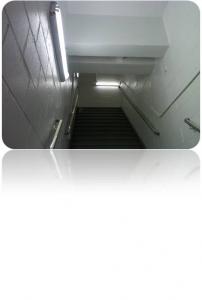
Sample Applications and the ROI:
A typical U.S. office may run 9 AM to 5 PM with an hour of operations on either end for a total of ten hours a day. This is a conservative approach to the energy evaluation, and the savings is only greater if the hours of illumination are longer in a particular office. At ten hours a day, five days a week, at an average rate of $.12 per kWh the cost to operate a typical 4’ 32 Watt T8 Fluorescent tube is about $10 per year. (The formula: Watts/1,000 x Hours = Kilowatt hours. The annual cost is simply the annual kWh x the cost per kWh.) For this 4’ LED tube retrofit baseline analysis, the 50 hours a week of office operation x 52 weeks per year equals 2,600 annual hours of illumination. 32W/1,000 x 2,600H = 83.2 annual kWh. 83.2kWh x $.12 = $9.98 per tube per year. Rounding it up, brings it to $10 of electricity per tube per year. This is a number that very few people have at hand, because the electricity for lighting is rarely sub-metered. The total electricity bill does not show that on average 30% of commercial electricity goes toward lighting, and the vast majority of commercial lighting is “linear” tubes.
The annual $10 cost per 4 ft.T8 fluorescent tube serves as a key benchmark. Think of the office as a single shift factor that can then drive the ballpark impact analysis for longer run time or higher costs per kWh applications. 4’ LED tube lights typically use only 15 Watts each, which is less than half of the electricity used by the incumbent 4’ fluorescent tubes. So, if a property owner or manger replaces a typical 4 ft. T8 fluorescent tube with a 4’ LED Tube light then the electricity savings is just over $5 per year, per tube. Many government retrofit programs require a minimum 10% Return on Investment (ROI) with paybacks inside of 10 years on energy technology retrofits. So, the cost of the LED tube lights and installation for the office single shift scenario could not exceed $50 per LED tube. In most cases, the cost of the LED tube retrofit and labor exceed this ceiling cost, so the path to efficiency involves “hunting” for a better application such as the 24/7 exit stairs.
The savings literally triples with the same LED tube lights if they are installed in the exit stairs vs. the office work areas. Think of the exit stairs as running three shifts. The same LED tube lighting works harder to save energy, but it does not cost more to purchase or install. For safety, exit stairs are typically illuminated 24/7. Here is the math: 24 hours a day x 365 days a year equals 8,760 annual hours of illumination. Using the same existing 4’ T8 fluorescent tube, the 32W/1,000 x 8,760H = 280.32 annual kWh. 83.2kWh x $.12 = $33.63 of electricity per tube, per year. The savings with the 4’ LED tube lighting retrofit is over $15 per year. With the government target of 10% ROI, the cost of the retrofit would cap out at $150 per tube. This is well within the cost structure of equipment and labor across the LED tube manufacturers and LED tube installers.
The private sector typically demands higher returns than the public sector. Given the high performance in 24/7 areas, LED tube distributors can more easily secure purchase orders, pass the savings on to the end user, and make their margin in the process. In many cases these 24/7 areas can deliver results with paybacks inside of three years and ROI over 33%. In addition to the long run time improving the payback performance, the cost of electricity and the inefficiency of the current lights are key contributors.
Many 4’ T12s use 45 Watts with the ballast and the cost of electricity for some Connecticut and New York facilities is $.20 per kWh. Here is the math on a 24/7 exit stair retrofit with T12s and high cost of electricity: 40W/1,000 x 8,760H = 394.2 annual kWh. 394.2kWh x $.20 = $78.84 per tube per year. The savings with the 4’ LED tube lighting retrofit is 66% since the LED tube uses 15 Watts vs. 45 Watts. The saving in dollars for each tube is $52.03 per year. By all standards, saving $50 per tube is exceptional with paybacks inside of two years and ROI over 50% for property owners.
Made in American LED Tube lights:
The photo in this article is from a fifty story, mid-town New York City high-rise retrofitted with 4’ LED tube lights by Independence LED Lighting, (www.IndependenceLED.com) a leading U.S. manufacturer of LED tube lights and multi-tube LED fixtures. See the LED Retrofit Photos of exit stairs and other 24/7 applications. The trend toward “Made in America” for LED tubes is rising in the LED sector as it is in other clean energy industries given the demands on quality manufacturing and domestic job creation.
Beyond exit stairs, other 24/7 applications for LED tube lights include, Parking Garage LED tubes, Hallway LED tubes for hospitals and college dorms, Industrial LED tubes for warehouse, distribution centers and factories, and Transit LED tubes for tunnels, subway systems, and airports. Overall, there are a surprisingly large number of areas that are illuminated around the clock which creates a platform for significant energy savings.

